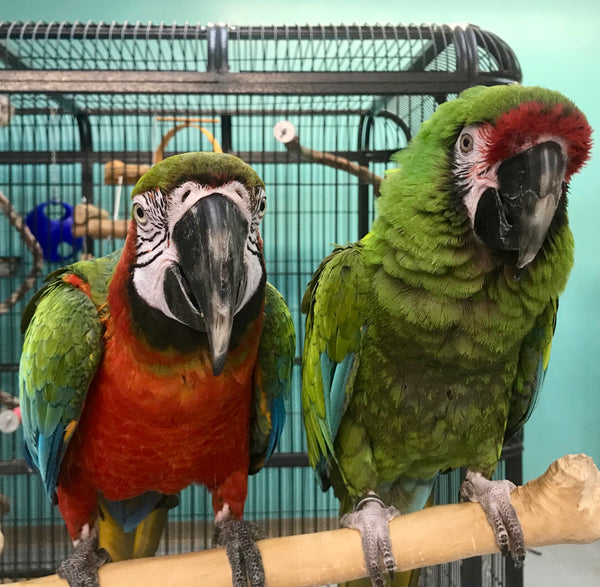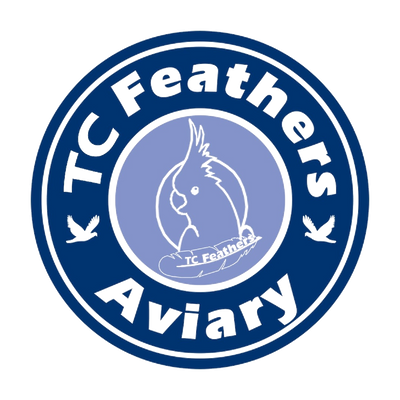At our aviary, we have many “store birds”. Some of these birds are our pets, some are rescues and some are birds that simply thrive in a bustling environment such as our aviary. The majority of our birds live with others of their own kind. Some are in pairs and some live in more of a community setting in a large, walk-in style cage. This is the story of one of our pairs of Macaws, Kirby and Suzie.

Eight years ago, I got my first Macaw. The baby was called a Harlequin Macaw. Harlequins are not a naturally occurring species in the wild. Instead, they are a hybrid between two nominate species (Greenwing + Blue & Gold). Sometimes hybrids occur intentionally and sometimes they are accidents. Much like in the dog world, mixing two different breeds of dogs has its advantages and its drawbacks. When it comes to parrots, ANY pro-creation and addition to the population is a big check in the win column. Sadly, most species of parrots, including Macaws, are endangered and some are even extinct. Poaching, habitat destruction, being hunted for food, and many other threats are all contributing to the decline of the wild population of Macaws.
Since Kirby is a store bird, he is around many other Macaws everyday. One of those Macaws is called Suzie. Suzie is a Military Macaw, which is one of the smaller species of full-size Macaws. Suzie is roughly 11 years old (her exact age is unknown as she was not a bird that was originally from our aviary). Over the last couple of years, Suzie made attempts to gain the companionship of several male Macaws living in our aviary. Even though she is a pretty girl, Suzie’s advances towards the boys were usually met with anything other than what she was looking for.
One day early this spring, all 7 of our resident Macaws were hanging out on the playground in the middle of the bird room. When it came time to put everyone away, we noticed that Kirby and Suzie were perched together and preening one another. Mutual preening, or “allopreening”, is usually a sign of affection in the world of birds. When preening, parrots let their guard down and are susceptible to predation. Preening activities signal a level of comfort and relaxation and is rarely observed when a bird is scared, nervous or under any level of stress.
In the spring, Kirby didn’t live in the big walk-in cage with the other Macaws because he can be rude in group situations, particularly toward the other male Macaws. So, when we noticed that he and Suzie were dating, we decided to try them together in Kirby’s cage. Moving in together is a big step, for parrots and humans alike. Suzie was initially confused by her new accommodations, but within a couple of days she had made herself at home. Kirby and Suzie were now a happy couple and going steady.
Although we breed several different species of parrots here at our aviary, we have never attempted to breed Macaws. The main reason is because of a lack of space but also because we had no true pairs to set up for breeding. Macaws take up a lot of space and when breeding, they need a nest box the size of a wine barrel. So when we noticed Kirby and Suzie starting to mate on a regular basis, we didn’t think much of it. Parrots are hard to breed even under ideal circumstances, let alone when not set up specifically for the purpose of breeding.
Despite all odds, Kirby and Suzie were determined to have a family. Well, Suzie was determined, Kirby just went along with it. One morning in early September, we came in to the store, turned all the lights on and went around the room doing checks on everyone like we always do. When we got to Kirby and Suzie’s cage, we found quite the surprise! Suzie had laid an egg overnight on the bottom of her cage! Over the next few days, she laid two more eggs for a total of three.
The eggs were surprisingly small, smaller than even a regular chicken egg. They were bright white and shiny. Because there was no nest box on her cage, Suzie laid her eggs on the bottom of the cage on top of the grate. Unfortunately, one of the eggs received a crack and was not going to develop or hatch. In an attempt to save the others, we decided to put the two remaining eggs into our incubator to give them a chance at hatching. Suzie was mad that we took her eggs, but after a few minutes was back to eating and playing and seemed relieved that she didn’t have to camp out on the bottom of her cage to sit on the eggs. We promised her that we will get her a proper nest box one day soon so that she can have the chance to raise babies herself.
So into the incubator the eggs went. Then the waiting began. The incubation period for Military Macaw eggs is 24 days. It is longer for Harlequins (because they are larger) but since Suzie was the mother, we went with the incubation period for her species. As the days progressed, we could see both eggs developing and veins started to become visible.

Three days before the eggs were due to hatch, the incubator stopped automatically turning the eggs. From this point on, we watched the eggs closely for signs of pipping (this is when the chick breaks through the shell of the egg). During these three days, we realized that one of the eggs had stopped developing and unfortunately was not going to hatch. While we were upset to discover this, and did not know what went wrong (mother nature rarely tells), we knew we had to focus on the remaining egg and get ready for the impending hatch day.
On Friday, October 5th, we were here late working to prepare for our ParrotFest event. Before we left, we checked the egg and noticed that it had started to pip. Once this happens, a chick will usually hatch within 24 hours. We anxiously walked into the nursery Saturday morning, turned on the lights and peered into the incubator. What we saw was truly amazing and maybe even a bit of a miracle. There was a tiny (compared to the other babies that hatch here maybe not so tiny), naked little chick laying in the tray of the incubator. His egg shell was kicked off to the side and he was sound asleep. We quickly scooped him out and put him into an already heated brooder to keep him warm.

Over the next week, Tammy got up every two hours (all night and all day) to feed this amazing little bird. He put on weight and grew at a rate we have never witnessed in a baby parrot before. We started trying to come up with names, but since we don’t know the gender it proved to be a challenge. Then our friend Mark said to us, “call him Kuzie!”. The K is from Kirby and the rest is from Suzie. So, the name stuck and now the baby will be called Kuzie…no matter what the gender turns out to be.
Naming Kuzie was not the only idea we had to come up with. Kuzie is what is known as a second generation hybrid. His father, Kirby, is a first generation hybrid (a nominate species mixed with another nominate species). This is where things start to get complicated, when one parent is already a hybrid (Kirby). So in our case, we have one hybrid parent and one nominate species parent (Suzie). When a combination like this occurs, it is considered a second generation hybrid (F2). As if that wasn’t complicated enough, we couldn’t find any documented record of a combination between a Harlequin Macaw and a Military Macaw. We did research, our friends and family did research, and we reached out to some professional organizations like the AFA. As far as we can tell, there was no such thing as a combination such as Kuzie, until now. Absent an already documented name for this type of hybrid, we are calling Kuzie’s species a “Miliquin Macaw”.
So what does a Miliquin Macaw look like? We have no idea. As with a lot of second generation hybrids, the appearance of each chick can vary drastically. Even in a clutch with multiple second generation hybrids, the chicks often look quite different from each other. And sometimes, the chicks look just like one of their parents. That is the case with one of our other store Macaws, Queso. Queso is a “Catablue Macaw” and is a second generation hybrid from a cross between a Catalina Macaw (Blue & Gold + Scarlet) and a regular Blue & Gold. But unless you were well-versed in Macaw hybrids, you would look at Queso and think he is a normal Blue & Gold. There are some very subtle differences about him that you’ll notice if you look closely enough.
As of the writing of this blog, Kuzie is just shy of four weeks old and already weighs over 600 grams. He is definitely on track to outweigh his mother and possible his father (Kirby is a big boy though, so we’ll see). Feathers on Kuzie’s tail and wings are just starting to poke through and show us hints of blues and greens.

Thanks for reading and stay tuned to our Facebook page for Kuzie updates and photos!
-The TC Feathers Crew

Carey - March 18, 2020
Paula – Kirby, Suzie, and Kuzie all still live at our aviary. You can come to visit them anytime :)
ASH Green - March 18, 2020
Thank you so much for such an informative piece of information :)
If anyone interested similar one’s have a look here
petcareio
Thanks
Liz - November 05, 2019
This is an awesome blog post, Carey! I enjoyed reading it.